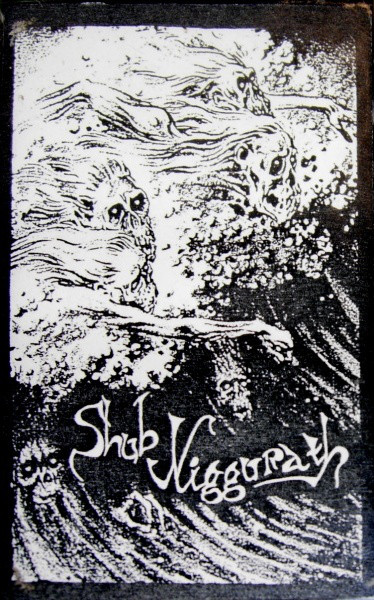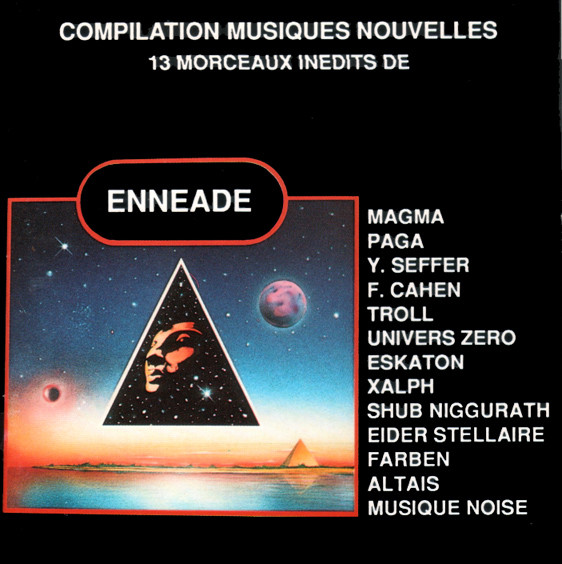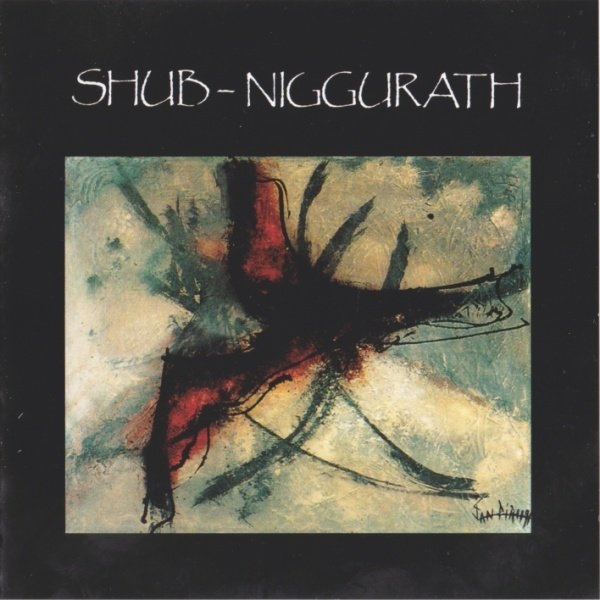
Exposé Online
What's old
Exposé print issues (1993-2011)
- 1 (October 1993)
- 2 (February 1994)
- 3 (May 1994)
- 4 (August 1994)
- 5 (October 1994)
- 6 (March 1995)
- 7 (July 1995)
- 8 (November 1995)
- 9 (March 1996)
- 10 (August 1996)
- 11 (February 1997)
- 12 (May 1997)
- 13 (October 1997)
- 14 (February 1998)
- 15 (July 1998)
- 16 (January 1999)
- 17 (April 1999)
- 18 (November 1999)
- 19 (May 2000)
- 20 (October 2000)
- 21 (March 2001)
- 22 (July 2001)
- 23 (December 2001)
- 24 (April 2002)
- 25 (September 2002)
- 26 (February 2003)
- 27 (August 2003)
- 28 (December 2003)
- 29 (April 2004)
- 30 (September 2004)
- 31 (March 2005)
- 32 (September 2005)
- 33 (May 2006)
- 34 (March 2007)
- 35 (January 2008)
- 36 (October 2008)
- 37 (July 2009)
- 38 (July 2010)
- 39 (Summer 2011)
Features
Music for Dark Gods —
A Profile of Shub-Niggurath

The enigmatic name is, or course, from Lovecraft. The phonetically bizarre world of Lovecraft's mythos has attracted many, many bands to use names of entities and places from its stories and legends. Shub-Niggurath, The Black Goat of the Woods with a Thousand Young, is a dark and terrible alien fertility goddess in the mythos, sometimes depicted as a demonic goat, sometimes as an enormous amorphous mass spawning her "Dark Young" — huge tentacled tree-like hulks with shaggy goats legs and hooves — in an endless orgy of reproduction. The extremity and sinister nature of such imagery suits the music of this band perfectly. If ever there were music for the mythos, this is surely the archetype.
by Phil Kime, Published 1997-02-01
 Shub-Niggurath formed in 1983 — six people with the goal of "the most extreme expression of [our] sensibility" and diverse influences from electroacoustic and modern jazz to 17th century Italian and contemporary classical.
Shub-Niggurath formed in 1983 — six people with the goal of "the most extreme expression of [our] sensibility" and diverse influences from electroacoustic and modern jazz to 17th century Italian and contemporary classical.
- Alain Ballaud: Bass
- Franck Coulaud: Percussion
- Frank Fromy: Guitar, Percussion
- Jean-Luc Hervé: Harmonium, Piano, Organ
- Ann Stewart: Vocals
- Véronique Verdier: Trombone, Bass
Their first untitled tape was released in 1985 and received quite a remarkable reception from the relevant specialist parts of the music press. The intensity of the music, controlled wonderfully as it was, became noted by many and much was expected of their planned debut album. During the wait for this, in 1986 someone with a sense of humour saw fit to include a live version of a track from this tape ("Yog-sothoth") on a compilation called Chant d'Amour. Somewhat ironic given Shub-Niggurath's place as dark fertility goddess in the Lovecraft mythos.
 The same line-up recorded the classic Les Morts Vont Vite for the then inchoate Musea label in 1987 and the tone of the reviews escalated considerably; Alan Freeman of Audion magazine prompted to remark at the time that Shub-Niggurath were "one of the most important bands to come out of France in the past eight years." Indeed, as a debut album — indeed as an album of any stage of a career — Les Morts Vonts Vite is quite astounding. Their debut self-confessedly caught them at the peak of their powers at the time. This is quite obvious when listening to it.
The same line-up recorded the classic Les Morts Vont Vite for the then inchoate Musea label in 1987 and the tone of the reviews escalated considerably; Alan Freeman of Audion magazine prompted to remark at the time that Shub-Niggurath were "one of the most important bands to come out of France in the past eight years." Indeed, as a debut album — indeed as an album of any stage of a career — Les Morts Vonts Vite is quite astounding. Their debut self-confessedly caught them at the peak of their powers at the time. This is quite obvious when listening to it.
 The album apparently sold quite well, particularly overseas, and the band were reportedly happy with Musea's distribution. Later in 1987, Musea issued the well-known Enneade compilation of zeuhl influenced music and tribute to the Magma legacy. Included was the track "J'ai vu naguère en rinture les harpyes ravissant le repas de phinée" by Shub-Niggurath. Apart from fuelling the Magma comparisons by simple association, this demonstrated to many that they were a real force in new music. Since Magma, by this time, had turned to their rather watered-down soul influenced style, Shub-Niggurath stood out and compared very favourably to their supposed mentor. Audion magazine proclaimed Shub-Niggurath's track "brilliant."
The album apparently sold quite well, particularly overseas, and the band were reportedly happy with Musea's distribution. Later in 1987, Musea issued the well-known Enneade compilation of zeuhl influenced music and tribute to the Magma legacy. Included was the track "J'ai vu naguère en rinture les harpyes ravissant le repas de phinée" by Shub-Niggurath. Apart from fuelling the Magma comparisons by simple association, this demonstrated to many that they were a real force in new music. Since Magma, by this time, had turned to their rather watered-down soul influenced style, Shub-Niggurath stood out and compared very favourably to their supposed mentor. Audion magazine proclaimed Shub-Niggurath's track "brilliant."
After this compilation was released, Franck Couland left the band to move into jazz and Frank Fromy also left. This left a rather gaping hole. Jean-Luc Hervé was forced to take on the guitar left by Fromy not, as he said reflecting on this a few years later, because he was really a guitarist but mainly because the guitar was not an optional instrument for Shub-Niggurath. The heavy concentration on timbre and sonority required textural instruments, or instruments that could be used in a textural manner and Hervé found the guitar to be perfect for this. He once remarked that it was used more as an electric sound source; more like a primitive synthesiser with an intuitive interface. In a telling phrase, an interview in 1990 had him saying he preferred "timbre to notes" and this largely explained his move from keyboards to guitar. It also provides a valuable insight in to Shub-Niggurath's approach to music.
1988 brought another compilation called Dithrambe which was more of a collaboration between Shub-Niggurath and Sleaze Art, a band composed of five bass players. The two tracks here were quite different; part two of the track on the Enneade compilation and another called "L'homme à l'habit gris"; a solo voice performance by Ann Stewart. Lacking a drummer and a guitarist — Hervé had to take over this lacuna — the sound is quite minimal and pared down. The work on this album was later to be thought by the band as having its faults. The departure of two central members was a problem and they came to regard the solo vocal track and the interpretation of the longer ensemble track as untypical of their output.
 Another track "Delear Prius" on the Douze pour un 2 compilation in 1989 was followed by the live tape release on Auricle the same year with a considerably changed line-up:
Another track "Delear Prius" on the Douze pour un 2 compilation in 1989 was followed by the live tape release on Auricle the same year with a considerably changed line-up:
- Alain Ballaud: Electric Bass
- Jean-Luc Hervé: Electric Guitar
- Véronique Verdier: Bass trombone, percussion
- Sylvette Claudet: Voice
- Michel Kervinio: Drums
- Jean-Pierre Lourdeau: Voice
Notice also that there had been some significant shuffling of instrumentation implying considerable musical versatility in the musicians. Recorded on Friday 13th, 1989 in Paris, this release demonstrated rather incredible ensemble playing and group intuition. Around this time, Jean-Luc Hervé commented in interview that the "core" of the band consisted of himself, Verdier, Kervinio, and Ballaud with others being drafted in for concerts and session work as necessary. Interviews from this time suggest that Kervinio was never permanently committed.
 1991 came and, at last, their first CD release, C'étaient de Très Grands Vents, on Musea. The line-up was almost the same with the addition of another percussion player and Jean-Pierre leaving to take up a career as a painter; he contributed the painting for the CD cover.
1991 came and, at last, their first CD release, C'étaient de Très Grands Vents, on Musea. The line-up was almost the same with the addition of another percussion player and Jean-Pierre leaving to take up a career as a painter; he contributed the painting for the CD cover.
- Alain Ballaud: Electric Bass
- Jean-Luc Hervé: Guitar, Piano, Harmonium
- Véronique Verdier: Bass trombone
- Sylvette Claudet: Voice
- Michel Kervinio: Drums
- Edward Perraud: Drums
The CD marked a change to a more electroacoustic style with a more spacious and subtle feel. The undercurrent of intensity remained. Since 1991, the band has recorded "many tapes" -- none released -- and performed as a four-piece consisting of Ballaud, Perraud, Hervé and Verdier. Small tours around the Paris area playing to specialist audiences have fuelled their continuing enthusiasm. In 1995, a rather unpleasant event occurred; Alain Ballaud died of cancer. He was central to the band in many ways and very active in its musical direction; Véronique Verdier stated recently that many things have to change in order for Shub-Niggurath to continue. As a first step, they plan to release a CD of material composed between 1991 and 1995, hoping for a 1997 release. The style of this work is apparently based around improvisation and electroacoustic experiments, following on their last recorded work.
As far as ex-members of the band are concerned, Sylvette Claudet is now a jazz clarinettist, Jean-Pierre Lourdeau paints, Michel Kervinio remains a friend of the band and plays in small jazz bands. Frank Fromy produces some things with Musea and has played with T. Toeplitz of Sleaze Art. He has also gathered together a little society of French musicians and works with them. Of the remaining members, Edward Perraud (the youngest member of the band) remains interested in jazz and classical percussion, electroacoustic music and music theory. Jean-Luc Hervé composes contemporary music for orchestra, soloists and chamber ensemble which is finding significant favour with recognised musicians. Apparently, he writes in the "spectral" style and has studied with Gérard Grisley. Véronique Verdier, after playing with some contemporary bands, has taken up an instrument called the "saqueboute," a quieter ancestor of the trombone. With this instrument she plays 17th century music (mainly Italian) in small bands, dabbling in Monteverdi and Mozart. This is not an instrument to feature in future Shub-Niggurath work as "... in Shub-Niggurath, the power of sound is very important: electric guitars are playing very loud."
Filed under: Profiles, Issue 11
Related artist(s): Shub-Niggurath
What's new
These are the most recent changes made to artists, releases, and articles.
- Review: Pietro Zollo - The Future Is Now
Published 2025-12-30 - Release: Dhope - Musical Exhibitions
Updated 2025-12-29 23:00:53 - Release: Tin Pan Alley - Tin Pan Alley
Updated 2025-12-29 22:51:10 - Release: Jeff Pearce - Infinite Ambient: Winter Landscapes
Updated 2025-12-29 22:33:12 - Release: Trio of Bloom - Trio of Bloom
Updated 2025-12-29 17:19:40 - Artist: Trio of Bloom
Updated 2025-12-29 17:16:50 - Artist: Craig Taborn
Updated 2025-12-29 17:02:15 - Release: Family - Old Songs, New Songs
Updated 2025-12-29 00:03:41 - Review: The Kirkbys - It's a Crime: The Complete Recordings
Published 2025-12-29 - Release: Various Artists - Psychedelic Underground 20
Updated 2025-12-28 23:33:26 - Artist: Dhope
Updated 2025-12-28 23:27:49 - Artist: Tin Pan Alley
Updated 2025-12-28 23:21:39 - Release: Various Artists - Psychedelic Underground 19
Updated 2025-12-28 23:04:15 - Review: Earthbound - Earthbound
Published 2025-12-28 - Review: Olgoj - A Place to Rest
Published 2025-12-27 - Release: John Weider - John Weider
Updated 2025-12-26 19:13:54 - Artist: John Weider
Updated 2025-12-26 19:09:52 - Release: Moonrider - Moonrider
Updated 2025-12-26 18:51:45 - Artist: Moonrider
Updated 2025-12-26 18:49:51 - Release: Octopus Syng - Insanity Is the Song We Sing
Updated 2025-12-26 12:53:35
